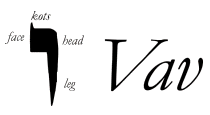|
|
 |
|
|
 |
 |
 |
|
The letter Vav is the sixth letter of the Aleph-Bet, having the numeric value of six. The pictograph for Vav looks like a tent peg, whereas the classical Hebrew script (ketav Ashurit) is constructed of a vertical line and conjoined Yod. The meaning of the word vav is "hook," as a connecting hook used when the mishkan (tabernacle) was assembled.
- The Mystery of Vav
The first Vav in the Torah occurs in Genesis 1:1:

The placement of the Vav suggests two of its essential connective powers:
- By joining heaven and earth (
 ) it implies the connection between spiritual and earthly matters. ) it implies the connection between spiritual and earthly matters.
- Since it occurs as the 22nd letter in the Torah attached to the sixth word,
 (et), it alludes to the creative connection between all of the letters. Vav is therefore the connecting force of the God, the divine "hook" that binds together heaven and earth. (et), it alludes to the creative connection between all of the letters. Vav is therefore the connecting force of the God, the divine "hook" that binds together heaven and earth.
- Vav and the Tabernacle (mishkan)
The word Vav is used in Exodus 27:9-10 to refer to the hooks of silver fastened to posts (called amudim) that were used to hold the curtain (yeriah) that encloses the tabernacle:
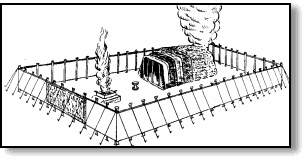
Just as the tabernacle was the habitation of God while the Israelites traveled in the wilderness, so the Torah is the habitation of His word today. Therefore, the scribes developed the idea that the Torah Scroll was to be constructed in the manner of the tabernacle. They called each parchment sheet of a scroll a yeriah, named for the curtain of the tabernacle (there are roughly 50 yeriot per scroll) and each column of text an amud, named for the post of the tabernacle's court.
Now since each curtain of the tabernacle was fastened to its post by means of a silver hook (vav), the scribes made each column of text to begin with a letter Vav, thereby "hooking" the text to the parchment:
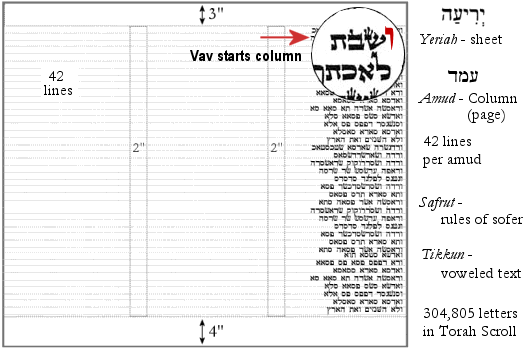
The laws of writing a Torah scroll are called soferut. There are over 4,000 "laws" or rules used by scribes to prepare a kosher scroll. For instance, the Torah must contain exactly 304,805 well-formed letters in 248 amudim (columns or pages). Each yeriah (sheet of parchment) must come from the hide of a kosher animal that has been specially perpared for the purposes of writing. Special inks are used and whenever a scribe writes any of the seven Names of God, he must say a blessing (l'shem k'dushat Hashem) and dip his quill in fresh ink.
A Torah scroll may contain no errors of any kind or it is considered passul (invalid). Each line of every amud is carefully read (backwards) by the sofer and compared against a working copy (called a tikkun). If an error is detected in a yeriah, it must be removed from the scroll and buried in a genizah, a sort of "cemetary" or repository for sacred texts (the most famous genizah is the Cairo Genizah).
- The Belly of the Torah
An oversized Vav marks the "center" of the entire Torah (Leviticus 11:42):

Appropriately enough, the word in which this Vav occurs is gachon, meaning "belly."
- Vav is a picture of Man
Since Vav represents the number six, it has long been associated as the number of man in the Jewish tradition:
- Man was created on the sixth day
- Man works for six days - the realm of the chol and the mundane
- There are six millennia before the coming of the Mashiach
- The "beast" is identified as the "number of a man" - 666 (Rev 13:18)
- The Broken Vav
Soferut (i.e., the laws concerning the scribal arts of writing Sefrei Torah) requires that all Hebrew letters be well-formed - that is, no letters can touch other letters and no letters can be malformed, broken, or otherwise illegible. However, there is a strange exception to these rules regarding the Vav that appears in the word "shalom" Numbers 25:12:

"Behold, I am giving to him my covenant of peace."
In a Torah scroll, the word shalom would be written like this:
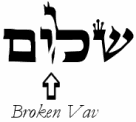
What is the significance of this broken Vav?
The story in Numbers chapter 25 is about Phineas (the grandson of Aaron the priest) and his zeal to remove evil from Israel by driving a spear through a man who was fornicating with a Moabite woman. On account of Phineas' act, God stopped the plague and Israel was delivered from destruction. From a Messianic point of view, we can see that Phineas is a type of Yeshua, since it is written that "he was jealous for his God and made atonement for the people of Israel" (Numbers 25:13).
On a "sod" level we can further think of this broken Vav as picture of the brokenness of the Messiah for our ultimate deliverance. How so? Well, since Vav represents the number of Man, the broken Vav represents a man that is broken. In this particular pasuk (verse), the man has been broken for the sake of a covenant of peace that brought atonement to Israel - another picture of the Messiah Yeshua and His ultimate deliverance for us.
- The Vav, Messiah, and New Creation
When God first created the "generations" of the heavens and the earth, the word toldot (תולדות) is used (Gen. 2:4). This refers to created order before the sin and fall of Adam and Eve. After the fall of Adam, however, the word is spelled differently in the Hebrew text, with a missing letter Vav (i.e., as תלדות). Thereafter, each time the phrase, "these are the generations of" occurs in the Scriptures (a formulaic way of enumerating the generations of the heads of families), the word is spelled "defectively," with the missing Vav (ו). The Vav was "lost." However, when we come to Ruth 4:18 the phrase: 'These are the generations of Perez' is spelled with the missing Vav restored (i.e., as תולדות). In all of Scripture, the only two places where we see the restored spelling is in Genesis 2:4 and Ruth 4:18, which leads to the question as to what connection there might be between the creation of the heavens and the earth, the fall of mankind, and the creation of the family line of Perez?
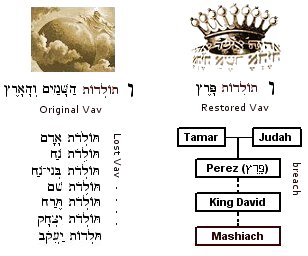
The name "Perez" (פרץ) means "breach" (from paratz, meaning "to break through"). God was going to "break through" the families of mankind in order to restore creation back to its original intent. The letter Vav represents man, and the very first Vav in the Torah is associated with the "first and last man" as seen in Genesis 1:1:

The Restored Vav is a picture of the Mashiach who would descend from the "generations" of Perez. He would be the one to breach the gates of death on our behalf. Just as the original Vav was lost through the first Adam and his sin, so the Vav is restored through the obedience of the "Second Adam," the Mashiach Yeshua.
|
|




